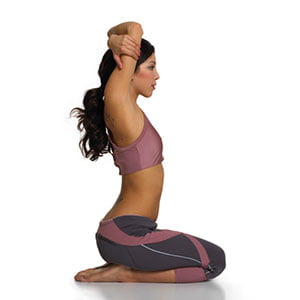How to do Janu Sirsasana, Head Beyond the Knee Pose – stretching, seated yoga posture.
Janu Sirsasana – Head Beyond the Knee Pose tones the liver, spleen and kidneys. Rather than aiming the head to the knee, creating a rounding of the back, aim to close the gap first between navel and thigh, then chest and thigh, and finally bringing the forehead to the shin.
Yoga classes in Milton Keynes with Yoga Lily.

2a. Raise the arms over the head.

2b. Fold the upper body forward and grasp the left foot with both hands

3. Increase the challenge by taking the right knee back and as far out to the side as possible.
Janu Sirsasana B

4. Janu Sirsasana B – Sit on the heel of the bent leg.

5. Loop the hands around the sole of the foot, clasping the left wrist in the right hand.
5. As you stay in the pose, keep moving the floating ribs forward. Roll the shoulders away from the ears. Loop the hands around the sole of the foot, clasping the left wrist in the right hand. Bend the elbows. Press the back of the left knee to the floor. Stretch out the toes. Increase the intensity of the stretch in the right lower back by pressing the right thigh and knee to the floor. Stay for 10 breaths or longer. Inhale to come up and repeat on the other side.
Tips
Gaze: Tip of the nose (with chin on shin, at toes)
Counter Poses:
Lighten:
- Sit on a folded blanket
- Grasp a belt looped around the ball of the foot
- For knee problems, slide the heel of the bent leg farther away from groin or extend the leg straight out to the side
Effect: Calming
Janu Sirsasana, Head Beyond the Knee Pose Counter Poses
In yoga we use a counter pose in a sequence; For example, a twist follows a backbend to “neutralise” the spine, or a forward bend follows a backbend to help lengthen the spine and calm the nervous system.



